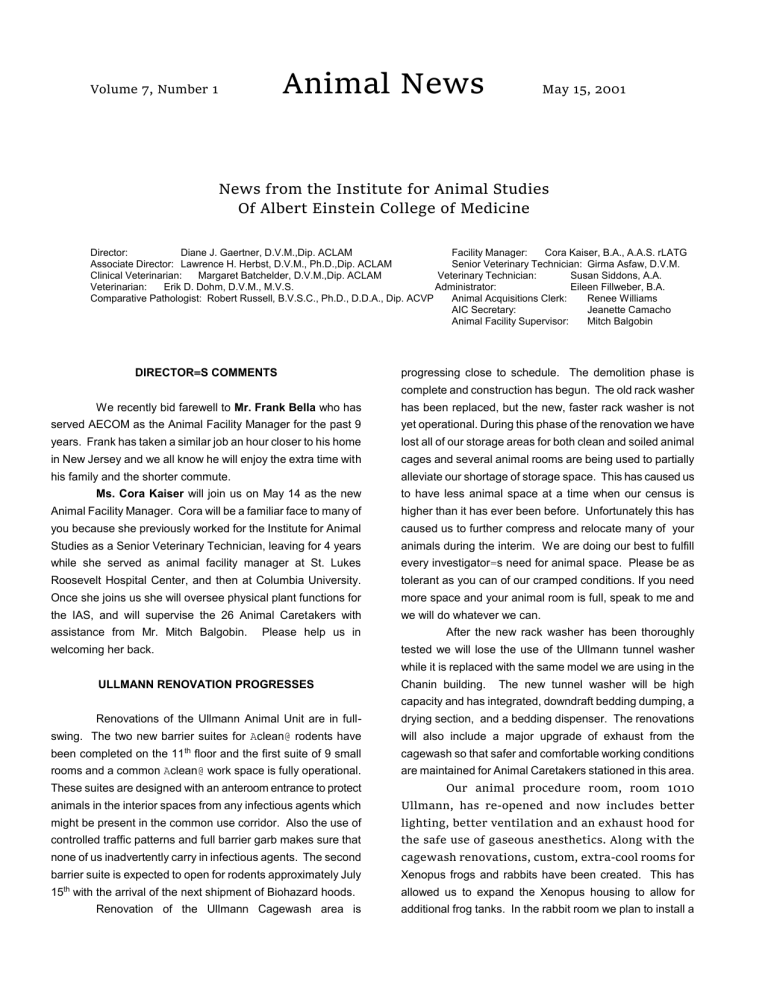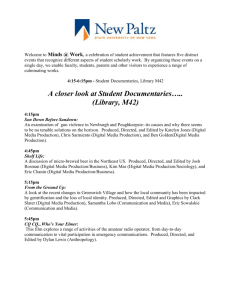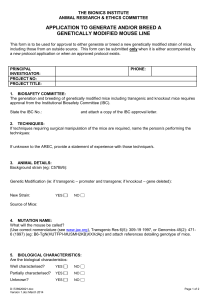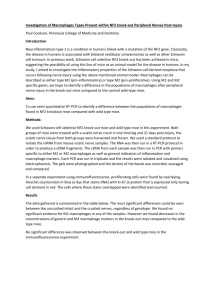Volume 7, Number 1 - Albert Einstein College of Medicine
advertisement

Animal News Volume 7, Number 1 May 15, 2001 News from the Institute for Animal Studies Of Albert Einstein College of Medicine Director: Diane J. Gaertner, D.V.M.,Dip. ACLAM Facility Manager: Cora Kaiser, B.A., A.A.S. rLATG Associate Director: Lawrence H. Herbst, D.V.M., Ph.D.,Dip. ACLAM Senior Veterinary Technician: Girma Asfaw, D.V.M. Clinical Veterinarian: Margaret Batchelder, D.V.M.,Dip. ACLAM Veterinary Technician: Susan Siddons, A.A. Veterinarian: Erik D. Dohm, D.V.M., M.V.S. Administrator: Eileen Fillweber, B.A. Comparative Pathologist: Robert Russell, B.V.S.C., Ph.D., D.D.A., Dip. ACVP Animal Acquisitions Clerk: Renee Williams AIC Secretary: Jeanette Camacho Animal Facility Supervisor: Mitch Balgobin DIRECTOR=S COMMENTS progressing close to schedule. The demolition phase is complete and construction has begun. The old rack washer We recently bid farewell to Mr. Frank Bella who has has been replaced, but the new, faster rack washer is not served AECOM as the Animal Facility Manager for the past 9 yet operational. During this phase of the renovation we have years. Frank has taken a similar job an hour closer to his home lost all of our storage areas for both clean and soiled animal in New Jersey and we all know he will enjoy the extra time with cages and several animal rooms are being used to partially his family and the shorter commute. alleviate our shortage of storage space. This has caused us Ms. Cora Kaiser will join us on May 14 as the new to have less animal space at a time when our census is Animal Facility Manager. Cora will be a familiar face to many of higher than it has ever been before. Unfortunately this has you because she previously worked for the Institute for Animal caused us to further compress and relocate many of your Studies as a Senior Veterinary Technician, leaving for 4 years animals during the interim. We are doing our best to fulfill while she served as animal facility manager at St. Lukes every investigator=s need for animal space. Please be as Roosevelt Hospital Center, and then at Columbia University. tolerant as you can of our cramped conditions. If you need Once she joins us she will oversee physical plant functions for more space and your animal room is full, speak to me and the IAS, and will supervise the 26 Animal Caretakers with we will do whatever we can. assistance from Mr. Mitch Balgobin. Please help us in welcoming her back. After the new rack washer has been thoroughly tested we will lose the use of the Ullmann tunnel washer while it is replaced with the same model we are using in the ULLMANN RENOVATION PROGRESSES Chanin building. The new tunnel washer will be high capacity and has integrated, downdraft bedding dumping, a Renovations of the Ullmann Animal Unit are in full- drying section, and a bedding dispenser. The renovations swing. The two new barrier suites for Aclean@ rodents have will also include a major upgrade of exhaust from the been completed on the 11th floor and the first suite of 9 small cagewash so that safer and comfortable working conditions rooms and a common Aclean@ work space is fully operational. are maintained for Animal Caretakers stationed in this area. These suites are designed with an anteroom entrance to protect Our animal procedure room, room 1010 animals in the interior spaces from any infectious agents which Ullmann, has re-opened and now includes better might be present in the common use corridor. Also the use of lighting, better ventilation and an exhaust hood for controlled traffic patterns and full barrier garb makes sure that the safe use of gaseous anesthetics. Along with the none of us inadvertently carry in infectious agents. The second cagewash renovations, custom, extra-cool rooms for barrier suite is expected to open for rodents approximately July Xenopus frogs and rabbits have been created. This has 15th with the arrival of the next shipment of Biohazard hoods. allowed us to expand the Xenopus housing to allow for Renovation of the Ullmann Cagewash area is additional frog tanks. In the rabbit room we plan to install a custom fencing system to house long-term rabbits in a social In the final phase of the Ullmann renovation all group. upgraded our vermin control within the animal facility by windows will be eliminated from animal rooms by replacing using a vendor specializing in research animal facility them with opaque glass and insulating layers behind a solid extermination (Bell Environmental). Although we surface. Although we all enjoy the view, natural light introduces previously had noticeable problems with feral mice and unnecessary variation in housing conditions for laboratory cockroaches, monthly testing now indicates that these animals and may unexpectedly affect your experimental results. vermin have been eliminated. This will be the final phase of renovations supported by the NIH renovation grant for the Ullmann Animal Unit. We have Unfortunately, this does not mean that we never see new or unexpected agents infecting your animals. benefitted from this grant not only by renovations, but also We are doing our best, but we need your help. through the purchase of movable caging equipment to furnish Investigators and collaborators play a key role in helping the renovated areas. Funds from the grant were matched 50% keep their rodents as Aclean@ as possible. Here are by funds from the AECOM Plant Fund. several ways that you can help: INVESTIGATOR TRAINING IS FREE AND FRIENDLY ! Make sure that tumors, cell lines and other biologicals for use in animals are always tested Dr. Erik Dohm, who joined the IAS last March, continues to prior to putting them into animals conduct a popular and informative series of seminars aimed at ! Never unnecessarily take animals to your lab the topics most needed by investigators and their collaborators. ! If you must house animals in your lab, keep them Training of all persons who use animals is overseen by the under Microisolator tops so that they cannot be Animal Institute Committee, as directed by the NRC Guide for the Care and Use of Laboratory Animals. Training topics exposed to loose rodents ! If you receive ADo Not Unpack@ shipments from include orientation to the use of experimental animals at other institutions, always spray off the outside of AECOM, how to write an animal protocol, training in rodent the shipping container with disinfectant before barrier procedures, training in rodent surgery procedures, and unpacking the animals, then discard the box and training in rodent handling, bleeding, anesthesia and bedding in trash receptacles outside of the euthanasia. Training in large animal surgery is available by request. The rodent handling training includes a lecture plus a animal facility ! hands-on session which many students and post-docs find helpful early in their research. The schedule of training Never bring in animals from other institutions without prior approval ! sessions is posted in each facility and on our internal website Avoid rodent pets - some infectious agents last up to 6 months in dust particles and can be at: carried in to work http://www.aecom.yu.edu/home/MouseHouse/Training.htm ! have new group members attend training Interested persons may sign-up for sessions in Ullmann 1005 or by contacting Ms. Jeannette Camacho, X 3572, jcamacho@aecom.yu.edu (Secretary to the Animal Institute Committee). If you have additional needs for training, or if REMINDERS (from previous issues): * http://www.aecom.yu.edu/home/MouseHouse/ * Forms and info sheets - just inside 1005 Ullmann you desire one-on-one training in a specific technique, you * Dr. Diane Gaertner coordinates animal quarantine should call Dr. Dohm at X 3723 to make an appointment. * Dr. Erik Dohm coordinates shipments from AECOM * Dr. Larry Herbst coordinates protocol review ANIMAL HEALTH REPORT / AOUTBREAKS@ * Fax animal orders to X 8556 The health of the experimental animals housed at AECOM is * Overcrowded mice must be separated within 6 days generally excellent. By utilizing our knowledge of the basic * Submit animal protocols 3 weeks in advance biology and epidemiology of agents infectious to rodents, we are making major progress Acleaning up@ endemic infections in research animal colonies and helping more research * Ketamine must be stored under double locks * Two mouse dams should not whelp in the same cage groups to use Aclean@ animals. This has admittedly been a * Cage cards must indicate the last name of the PI process which has involved some trial and error, but we are * Animal orders must be placed by 12:00 noon Thursday confident that we are now using highly effective quarantine, * Get permission before moving your animals re-derivation and quality assurance programs. We have also * IAS and AIC office hours are 8:30 - 4:30 M-F Your colleagues have asked me to repeat my survey of rodent genotypes being bred at AECOM. I will publish the results in the next issue, so please respond to the survey below if you have breeding colonies you are willing to list. Please send this information by E-mail to gaertner@aecom.yu.edu, mail or fax the form below to Dr. Gaertner at X 8556 ................................................................................................................................................................................... Name of Principal Investigator _________________________________________________________________ Species of animal ___________________________________________________________________________ Name of mutation or genetic manipulation _______________________________________________________ Housing location of animals Chanin Animal Barrier Facility (Chanin 6th floor) Ullmann Plastic Film Isolator Facility (1105 Ullmann) Ullmann Clean Barrier Suite (Room 1117) Ullmann - other rooms Kennedy Center Barrier Rooms (B 20 and B 24) Kennedy Center - other rooms Listed below are the breeding colonies you listed as being available at AECOM in February, 2000. This list is provided as a resource for AECOM investigators, availability of animals is not guaranteed. All colonies are mice unless otherwise noted. Please provide to me by e-mail any corrections to this list. PI Name Angeletti, R Bregman, D Brion, L Burk,R Diamond, B Diamond, B Diamond, B Diamond, B Diamond, B Diamond, B Diamond, B Diamond, B Diamond, B Diamond, B Diamond, B Gupta, S Gupta, S Kucherlapati, R Kucherlapati, R Kucherlapati, R Kucherlapati, R Kucherlapati, R Kucherlapati, R Kucherlapati, R Kucherlapati, R Kucherlapati, R Kucherlapati, R Lisanti, M Lisanti, M Lisanti, M Pollard, J Pollard, J Pollard, J Pollard, J Raine, C Raine, C Raine, C Rogler, C Skoultchi, A Stanley, P Stanley, P Stanley, P Stanley, P Mutation, Transgene or Knock-out KC receptor knock-out CS-B carbolic anhydrase II deficiency (mutation) Location U 1117 # Chanin 6 KC conventional* HBV transgene - near albino locus Ullmann dominant negative CREB transgenic mice Chanin 6 anti-DNA IgG heavy Chanin transgenic mice Chanin 6 CD4 knock-out mice Chanin 6 dominant negative fad transgenic mice Chanin 6 dominant negative estrogen receptor - T cell promoter Chanin 6 dominant negative estrogen receptor - B cell promoter Chanin 6 dominant negative fas transgenic mice Chanin 6 C(mu) knock out mice Chanin 6 anti-DNA IgM heavy chain transgenic mice Chanin 6 RAG knockout mice Chanin 6 T15 heavy chain transgenic mice Chanin 6 FVB/N-mdr2 knock-out mice Ullmann conventional LEC, LEA, (rats) Ullmann conventional Msh 2 (k/o) Chanin 6 MCh1 (k/o) Chanin 6 Apc1638 (k/o) Chanin 6 Msh6 (k/o) Chanin 6 Msh 5 (k/o) Chanin 6 Mcc (k/o) Chanin 6 Smad2 (k/o) Chanin 6 Arv (k/o) Chanin 6 Ker 4 (k/o) Chanin 6 Map1b (k/o) Chanin 6 transgenic mice expressing Caveolin-2 Chanin 6 transgenic mice expressing Caveolin-1 Chanin 6 transgenic mice expressing Caveolin-3 Chanin 6 csfm P - csf-1 null, ostopetrotic Chanin 6 p27 -/- cell cycle inhibitor null Chanin 6 cyclin D1 -/- cell cycle regulator null Chanin 6 MMTV - middle t - cancer susceptible Chanin 6 GFAP knock-out Ullmann conventional TNFR-1 knock-out Ullmann conventional CCR-2 knock-out Ullmann conventional Rag 2 k/o, human growth factor 2 transgene in liver, AlbUPA tg Ullmann and Chanin 6 H1 histone genes and combinations in the DiGeorge region Chanin 6 GlcNAc-TI knock-out Chanin 6 GlcNAc-TIII disruption / knock-out Chanin 6 GlcNAc-TIII deletion knock-out Chanin 6 GlcNAc-tIII transgene under MUP promoter Chanin 6 # all mice are Aclean@ and are housed under barrier conditions unless otherwise specified * mouse colonies housed in conventional space are enzootically infected with coronaviruses (Mouse Hepatitis Virus) and may also be infected with mouse parvoviruses or other murine viruses






